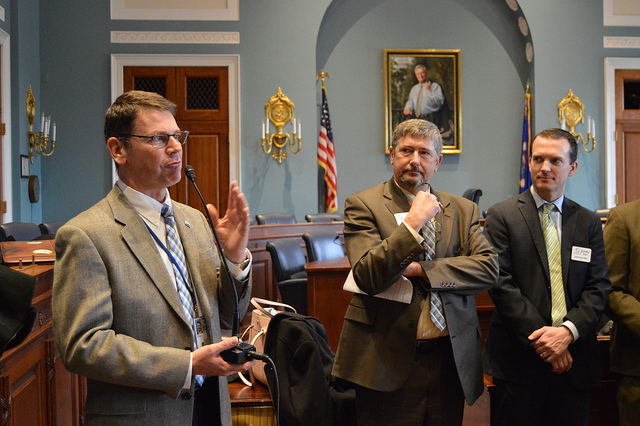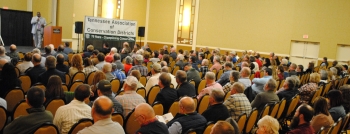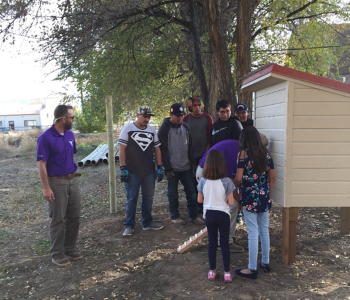CONSERVATION DISTRICT LEADERS TAKE TO
CAPITOL HILL
On Wednesday, Mar. 13, conservation district officials from across the nation descended upon the nation’s capital as part of NACD’s 2019 Spring Fly-In. More than 150 district representatives from over 30 states took to Capitol Hill to educate their federal representatives about and advocate for voluntary, locally-led conservation.
“Now is a perfect time to educate the new members of the 116th Congress about the work conservation districts do,” NACD President Tim Palmer said. “Our grassroots efforts are the most important and impactful of the things that we do.”
During the evening’s Congressional Reception, attendees heard from Representative K. Michael Conaway (R-Texas), Representative Ralph Abraham (R-Louisiana), and Natural Resources Conservation Service (NRCS) Chief Matt Lohr.

“Conservation districts are our main partner all across this country,” Lohr said. “I want to thank you so much for the good work you do. Thank you for the collaboration, thank you for the work that you’re doing independently and really being able to come here this week to tell the story.”
Rep. Conaway, ranking member of the House Committee on Agriculture, discussed the strength of the 2018 Farm Bill and its historic 369 votes. “The reason it got that kind of support is…all of you have done a terrific job of communication to the urban members and the suburban members just why good agriculture policy is important to this nation,” Rep. Conaway said. “You collectively were a part of making that happen.”
JOINT FORESTRY TEAM MEMBERS SIGN MOU
Forestry leaders gathered in Washington, D.C., this week for the annual in-person Joint Forestry Team (JFT) meeting. The group set its 2019 priorities, began initial planning for a summer field tour, and heard from leadership who later signed a five-year memorandum of understanding (MOU) (pictured).

The JFT consists of members representing the U.S. Forest Service, Natural Resources Conservation Service (NRCS), National Association of State Foresters (NASF) and NACD. Jennifer Hinkhouse (Wyo.), Tom Crowe (Ind.) and John McAlpine (Ark.) represent NACD, and Hinkhouse serves as JFT’s chair. To learn more, visit jointforestryteam.org.
TENNESSEE HOLDS 75th ANNUAL CONVENTION
On Mar. 2-5, over 350 conservation district supervisors, employees and partners gathered in Gatlinburg, Tenn. for the Tennessee Association of Conservation Districts’ (TACD) 75th Annual Convention. The theme of the event was “From Foundation to Future Generations: 75 Years of Championing Conservation.”

NACD Alternate Board Member Roy Gillis spoke about the history of Tennessee’s districts during the opening ceremony, followed by a video celebrating the districts’ people and projects over 75 years. Natural Resources Conservation Service (NRCS) Chief Matt Lohr provided the keynote address, and participants also heard from new NRCS State Conservationist Sheldon Hightower (pictured).
At the event’s annual awards breakfast, the Cumberland County Soil Conservation District, winner of the 2018 NRCS Earth Team Award, and state and national poster contest winners were recognized. Mendel Wade of Crockett County was presented with the Tennessee Conservation District Employees Association’s Employee of the Year Award by Janice Gilispie, winner of the National Conservation District Employee Association’s 2018 Outstanding Conservation District Employee Award. Jerry Adams and Richard Thompson of Franklin County were also recognized as Conservation Farmers of the Year, and the Cumberland River Compact received a Conservation Promotion award for their “River Friendly Agriculture” education and outreach efforts.

SAN JUAN SWCD, NEW MEXICO
In 2017, the San Juan Soil and Water Conservation District (SWCD) in northwestern New Mexico received funding through the Urban Agriculture Conservation Grant Initiative, a partnership between NACD and the Natural Resources Conservation Service (NRCS) to increase technical capacity in urban and expanding areas. Through this funding, the district created a project called “Farm Farmington!” The project was structured with a tiered approach.
The first tier provided conservation technical assistance, supplies and capacity-building support to the New Beginnings Community Garden (NBCG) located at the New Beginnings transitional housing program for survivors of domestic violence and their families. Outcomes at NBCG include 14 raised garden beds, a plumbed 2,500-gallon water storage tank, a soil health plan, a chicken run and coop with resident-managed hens, recommendations for prairie dog and deer management and the “New Beginnings Community Garden Operations Manual,” which was printed and presented to the NBCG community and will serve as a model for other gardens in the area.
The next tier of focus provided a combination of supplies funding, conservation technical assistance and programmatic and capacity-building support to five other “growing” gardens and organizations in the area, including the Samaritan Village Community Garden and Four Corners Foundation’s community garden at PATH, a transitional housing center. Highlights included a composting workshop at First Baptist Church-Bloomfield Community Garden and publication of the “Low Cost Home Gardening Guide,” which was put on display at the Tres Rios Habitat for Humanity Store.
The third approach can be summarized as “connecting the dots.” Farmington had a number of projects, groups and resources dedicated to urban and community agriculture, but community members reported difficulty finding these groups and working together on shared goals. In response to these challenges, the district brought people together in new ways as well as plugged them in to existing planning efforts. An advisory committee was assembled with community gardeners, agency representatives and others, and has now transitioned into a Local Foods Task Force after receiving an Enviromental Protection Agency (EPA) “Local Foods, Local Places” grant.
The final step made resources and information more accessible to the community by producing the Farm Farmington! Guide to Urban and Community Agriculture in the San Juan River Valley. This guide includes a map of local agriculture initiatives in the area, regional land use history, resources for starting a garden, suggestions for creative partnerships and more.

In the photo above, San Juan College Carpentry Program students and instructors deliver and set up the chicken coop they built for New Beginnings Community Garden as a class project while two New Beginnings residents watch. This photo captures just one of the many creative partnerships that came out of the Farm Farmington! initiative.
|
|
|
|
|
Email Marketing By
|


|
|
|
|
|